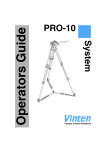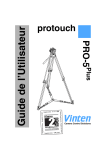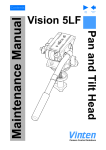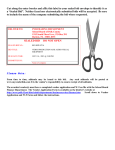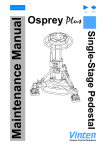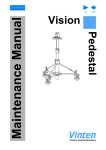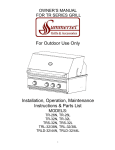Download Vinten protouch Pro-10 system Technical data
Transcript
PRO-6HDV System Operators Guide protouch Vinten Camera Control Solutions Back protouch HDV PRO-6 System Publication Part No. V4018-4980Issue 3 Copyright © The Vitec Group plc 2007 All rights reserved throughout the world. No part of this document may be stored in a retrieval system, transmitted, copied or reproduced in any way including, but not limited to, photocopy, photograph, magnetic or other record without the prior agreement and permission in writing of The Vitec Group plc. Vinten® is a registered trademark of The Vitec Group plc. 2 Back Preface Thank you and congratulations on your new Protouch PRO-6HDV system from Vinten We want you to get the most from your new PRO-6HDV system, and therefore encourage you to read this operators guide to familiarise yourself with its many features, some of which may be new to you. It also covers essential health and safety information and a section on maintenance that will ensure you keep your new product in perfect condition. To receive additional benefits, register with Vinten now on line by visiting www.vinten.com/register. Features and benefits of your new PRO-6HDV system The PRO-6HDV system is perfectly suited for event videography, corporate and ENG applications using DV and mini-HDV format cameras. • Maximum payload 6 kg (13.2 lb). • 3 step (plus zero) spring counterbalance system for positive camera control. • Top-loading ‘Side Load’ quick-release slide plate, with 1/4 in. and 3/8 in. camera screws and locating pin, accommodates all cameras. • Illuminated levelling bubble for convenient low-light set up. • Cam-operated tripod clamping system requires low effort with a 90° turn from on to off, providing the user with a positive indication that the tripod is securely locked. • Extensive tripod height range and unrivalled torsional stiffness. Once again, thank you for choosing the PRO-6HDV system. We are confident it will give you many years of reliable performance. 3 Back Safety - Read This First Warning Symbols in this Operators Guide Where there is a risk of personal injury, injury to others, or damage to the head, tripod or associated equipment, comments appear, highlighted by the word and supported by the warning triangle symbol. Technical Data PRO-6HDV pan and tilt head Weight Head with bowl clamp 1.95 kg (4.29 lb) Pan bar 0.25 kg (0.55 lb) Height to mounting face 12.4 cm (4.9 in.) Length 12.2 cm (4.8 in.) Width 17.5 cm (6.9 in.) Load capacity Tilt range Pan range Tripod fixing 6 kg (13.2 lb) +90° -60° 360° 75 mm ball Pozi-Loc tripod Levelling bowl diameter 75 mm Maximum height with floor spreader 156.2 cm (61.5 in.) Minimum height with floor spreader 41.6 cm (16.4 in.) Maximum height with mid-level spreader 155.6 cm (61.26 in.) Minimum height with mid-level spreader 53.6 cm (21.1 in.) Weight Transport length Recommended maximum load 3.2 kg (7.0 lb) 71 cm (28.0 in.) 25 kg (55 lb) Floor spreader Maximum leg radius 77 cm (22.5 in.) Minimum leg radius 38 cm (15 in.) 4 Back Weight 0.7 kg (1.5 lb) Mid-level spreader Maximum spreader radius 97.7 cm (38.4 in.) Minimum spreader radius 16.2 cm (6.3 in.) Weight 0.48 kg (1.05 lb) Further information For full details on maintenance and spare parts, please refer to protouch PRO-6HDV System Maintenance Manual and Illustrated Parts List (Publication Part No. V4018-4990) This is obtainable from Vinten or your local Vinten distributor. For information on-line, visit our website at www.vinten.com. 5 Back Contents Page Preface . . . . . . . . . . . . . . . . . . . . . . . . . . . . . . . . . . . . . . . . . . . . . . . . . . . . . . . . . . . . . . . . . . . . 3 Safety - Read This First . . . . . . . . . . . . . . . . . . . . . . . . . . . . . . . . . . . . . . . . . . . . . . . . . . . . . . 4 Technical Data. . . . . . . . . . . . . . . . . . . . . . . . . . . . . . . . . . . . . . . . . . . . . . . . . . . . . . . . . . . . . . 4 Further information. . . . . . . . . . . . . . . . . . . . . . . . . . . . . . . . . . . . . . . . . . . . . . . . . . . . . . . . . . 5 Introduction PRO-6HDV pan and tilt head . . . . . . . . . . . . . . . . . . . . . . . . . . . . . . . . . . . . . . . . . . . . . . . . 12 Pozi-Loc tripod . . . . . . . . . . . . . . . . . . . . . . . . . . . . . . . . . . . . . . . . . . . . . . . . . . . . . . . . . . . 13 Tripod spreaders . . . . . . . . . . . . . . . . . . . . . . . . . . . . . . . . . . . . . . . . . . . . . . . . . . . . . . . . . 13 Operation Assembly Tripod and floor spreader . . . . . . . . . . . . . . . . . . . . . . . . . . . . . . . . . . . . . . . . . . . . . . . . 14 Tripod and mid-level spreader . . . . . . . . . . . . . . . . . . . . . . . . . . . . . . . . . . . . . . . . . . . . 14 Pan and tilt head. . . . . . . . . . . . . . . . . . . . . . . . . . . . . . . . . . . . . . . . . . . . . . . . . . . . . . . 16 Mounting the camera . . . . . . . . . . . . . . . . . . . . . . . . . . . . . . . . . . . . . . . . . . . . . . . . . . . . . . 16 Checking camera balance . . . . . . . . . . . . . . . . . . . . . . . . . . . . . . . . . . . . . . . . . . . . . . . . . . 17 Pan and tilt brakes . . . . . . . . . . . . . . . . . . . . . . . . . . . . . . . . . . . . . . . . . . . . . . . . . . . . . . . . 19 Pan and tilt drag. . . . . . . . . . . . . . . . . . . . . . . . . . . . . . . . . . . . . . . . . . . . . . . . . . . . . . . . . . 19 Optional equipment Carrying strap . . . . . . . . . . . . . . . . . . . . . . . . . . . . . . . . . . . . . . . . . . . . . . . . . . . . . . . . . . . 20 Dollies . . . . . . . . . . . . . . . . . . . . . . . . . . . . . . . . . . . . . . . . . . . . . . . . . . . . . . . . . . . . . . . . . 21 Servicing General . . . . . . . . . . . . . . . . . . . . . . . . . . . . . . . . . . . . . . . . . . . . . . . . . . . . . . . . . . . . . . . . 22 Cleaning. . . . . . . . . . . . . . . . . . . . . . . . . . . . . . . . . . . . . . . . . . . . . . . . . . . . . . . . . . . . . . . . 22 Routine maintenance. . . . . . . . . . . . . . . . . . . . . . . . . . . . . . . . . . . . . . . . . . . . . . . . . . . . . . 22 Battery replacement . . . . . . . . . . . . . . . . . . . . . . . . . . . . . . . . . . . . . . . . . . . . . . . . . . . . 23 Adjustments Pan brake knob adjustment . . . . . . . . . . . . . . . . . . . . . . . . . . . . . . . . . . . . . . . . . . . . . . 24 Tilt brake knob adjustment . . . . . . . . . . . . . . . . . . . . . . . . . . . . . . . . . . . . . . . . . . . . . . . 25 ‘Pozi-Loc’ tripod leg clamp adjustment . . . . . . . . . . . . . . . . . . . . . . . . . . . . . . . . . . . . . . 26 Parts list. . . . . . . . . . . . . . . . . . . . . . . . . . . . . . . . . . . . . . . . . . . . . . . . . . . . . . . . . . . . . . . . . . 28 Associated publications Protouch PRO-6HDV System - Maintenance Manual Publication Part No. V4018-4990 6 Back (1) (2) (3) (19) (18) (4) (17) (5) (16) (6) (15) (7) (8) (14) (13) (12) (11) (10) (9) Fig 1 PRO-6HDV Pan and Tilt Head 7 Back (1) Camera slide plate release (2) Camera slide plate clamp (3) Tilt drag control (4) Tilt brake (5) Locating pin (6) 1/4 in. camera screw (7) 3/8 in. camera screw stowage (8) Balance selector (9) Pan bar (10) Bowl clamp (11) Illuminated levelling bubble (12) Illumination module (13) Levelling bubble illumination switch (14) Pan drag control (15) Pan brake (16) Pan bar mounting (17) Camera slide plate (18) Camera slide plate bung (19) 3/8 in. camera screw 8 Back (27) (20) (26) (21) (25) (24) (23) (22) Fig 2 Pozi-Loc Tripod and Floor Spreader 9 Back (20) Tripod bowl (21) Clamp knob (22) Floor spreader (23) Floor spreader adjuster (24) Foot securing strap (25) Leg tie strap (26) Attachment point for mid-level spreader (27) Tie down hook 10 Back (28) (26) (30) (33) (29) (31) (32) Fig 3 Pozi-Loc Tripod and Mid-level Spreader (28) Spread knob (29) Clamp knob (30) Attachment release buttons (31) Attachment pins (32) Carpet feet (33) Rubber strap 11 Back Introduction There are two protouch PRO-6HDV systems from Vinten. Both systems comprise of a PRO-6HDV pan and tilt head, a Pozi-Loc two-stage tripod and a soft case. However, one system (PRO-6 HDVF) is supplied with an adjustable floor spreader and the other (PRO-6 HDVM) comes with an adjustable mid-level spreader. PRO-6HDV pan and tilt head The PRO-6HDV pan and tilt head (Fig 1) is designed to support the latest professional digital video cameras, up to 6 kg (13.2 lb) in weight. It embodies fluid drag assemblies for pan and tilt motions with brakes on each axis to lock the head in any position. An illuminated levelling bubble is fitted to the rear of the head and a quick-release, side-loading adjustable slide plate is provided for camera mounting. A single fixed pan bar is supplied. Balance The selectable balance range in the PRO-6HDV pan and tilt head is set for payloads of 2.5 kg (5.5 lb) to 6 kg (13.2 lb) at a centre of gravity (C of G) height of 5.5 cm (2.2 in.). The graph (Fig 5) shows the relationship between C of G height and payload for optimum performance. Pan and tilt drag Both the pan and tilt mechanisms incorporate fluid drag assemblies to ensure smooth movement of the camera about these axes and are fitted with control knobs (3) (14) to adjust the drag setting. Pan and tilt brakes Brakes (4) (15) on each axis are provided to lock the head in any position Illuminated levelling bubble To enable the head to be levelled, an illuminated levelling bubble (11) is fitted to the rear of the head. When the switch (13) is pressed, the bubble will be illuminated for approximately 15 seconds. The battery for the illuminated bubble is contained in a illumination module (12). The switch (13) will illuminate when the battery needs replacing. Camera mounting The camera is attached to the head by means of a slide plate (17), which is provided with a springloaded locating pin (5) and 1/4 in. (6) and 3/8 in. (19) screws. When not in use, the screws are stowed in the camera mounting platform (7). The slide plate (17) is loaded from above into the side-loading clamp mechanism, and a clamp (2) is provided to hold the slide plate in position. The release button (1) allows removal of the slide plate (17) from the head. Pan bar Pan bar mounting points (16) are located at the rear of the head, on either side of the camera mounting platform. The pan bar (9) is attached using a pan bar clamp, with angular adjustment available on the mount serrations. A single fixed pan bar (9) is supplied. A second pan bar may be fitted. 12 Back Pozi-Loc tripod The Pozi-Loc two-stage tripod (Fig 2) has aluminium legs and a 75 mm levelling bowl (20). It is fitted with the highly-efficient Pozi-Loc leg clamp (21), which provides quick set-up and easy adjustment. Tripod spreaders Depending on which PRO-6HDV system was purchased, the tripod is supplied with either a floor spreader (Fig 2) or a mid-level spreader (Fig 3). Both tripod spreaders increase the rigidity of the tripod. PRO-6 HDVF system The PRO-6 HDVF system utilizes a floor spreader (Fig 2) which, being flexible, compensates for uneven ground, protects floors and carpets and prevents the tripod legs sinking into soft ground. It should be used at all times. NOTE: Always use the spreader where possible as this increases rigidity of the tripod. Being flexible, the spreader compensates for uneven ground. It can be removed and a dolly fitted. At the fullest extension of the spreader and with all legs fully retracted, the tripod can be used at its lowest operating height. Although the tripod can be set up lower than this without the spreader, it is NOT recommended as the tripod geometry becomes unstable Each arm is of the spreader is adjustable for length (23) and the tripod feet are secured by rubber straps (24). PRO-6 HDVM system The PRO-6 HDVM system utilizes a mid-level spreader (Fig 3) which fastens to the attachment points (26). There are two spread settings, controlled by a knob (28), and the arm lengths can be adjusted using the extension clamps (29) to compensate for uneven ground. A set of three feet (32) are also supplied with this system to protect floors and carpets and prevents the tripod sinking into soft ground. The feet are secured to the tripod by rubber straps (33). NOTE: Always use the spreader where possible as this increases rigidity of the tripod. Adjustable extension clamps compensate for uneven ground. The spreader can be removed and a dolly fitted. At the fullest extension of the spreader and with all legs fully retracted, the tripod can be used at its lowest operating height. Although the tripod can be set up lower than this without the spreader, it is NOT recommended as the tripod geometry becomes unstable 13 Back Operation Assembly If not already done, assemble the system as follows: Tripod and floor spreader To install the floor spreader (Fig 2): Lift the tripod out of the case using the finger holes just below the top clamps. Release the leg tie strap (25) and spread the legs. Secure the spreader to the tripod feet with the rubber straps(24). NOTE: Once assembled, keep the spreader attached to the tripod To adjust the tripod: Adjust the operating height by undoing the leg clamps (21) and pulling the tripod up to the desired height. Adjust the spreader (23) if necessary. Tighten the clamps (21) until an audible click is heard and the knob is in the horizontal, locked position. In adverse conditions secure the tripod using the tie-down hook (27), or suspend a weight from the hook. WARNING! Use care when the tripod is fully extended and the floor spreader is in the closed position, as stability will be reduced. Tripod and mid-level spreader To install the mid-level spreader (Fig 3): Grip the ends of each spreader arm in turn between thumb and fore-finger and press in both attachment release buttons (30). Push the arm into the tripod attachment (26) ensuring the attachment pins (31) engage. Secure the carpet feet (32) onto the tripod feet using the rubber straps (33). NOTE: The carpet feet attach using rubber straps in the same way as the floor spreader (23). 14 Back To remove the spreader, press in the attachment release buttons (30) and free each arm in turn. To adjust the mid-level spreader: There are two spread settings. To select maximum (flat) spread, lift the spreader centre moulding such that lugs can pass the extension arms, and rotate the spread knob (28) fully clockwise. To select minimum (45°) spread, lift the spreader centre moulding and rotate the spread knob (28) fully anticlockwise. NOTE: The spread knob (28) will not rotate when the spreader is loaded. Lift the spreader centre moulding to allow the knob (28) to rotate freely. A pointer on the knob (28) indicates maximum or minimum spread setting. Extension arms can be individually adjusted by releasing the extension clamps (29), extending the arm as required and re-tightening the clamp (29). NOTE: Do NOT attempt to fold the tripod if the spreader extension arms are uneven lengths. Set all extension arms to the same length (29) and then fold the tripod. To adjust the tripod: Adjust the operating height by undoing the leg clamps (21) and pulling the tripod up to the desired height. Adjust the spreader (29) if necessary. Tighten the clamps (21) until an audible click is heard and the knob is in the horizontal, locked position. In adverse conditions secure the tripod using the tie-down hook (27), or suspend a weight from the hook. WARNING! Use care when the tripod is fully extended and the floor spreader is in the closed position, as stability will be reduced. 15 Back Pan and tilt head The PRO-6HDV pan and tilt head (Fig 1) is supplied with a 75 mm ball mount. Adaptors are available which enable the head to be installed on tripods or pedestals fitted with other mountings. These are listed under ‘Optional Accessories’. To install the head, remove the bowl clamp assembly (10) from the head, position the head on the tripod and refit the bowl clamp assembly from below. Level the head with the aid of the level bubble (11) and tighten the bowl clamp (10). The level bubble may be illuminated by pressing the switch (13). The light will extinguish after approximately 15 seconds. NOTE: After unpacking the product, to initially illuminate the level bubble, a paper transportation tab must be removed from the battery. To access the battery, see ‘Battery replacement’ on page 23. Mounting the camera Remove the slide plate (17) from the head (Fig 1) by releasing the slide plate clamp (2), pressing the slide lock release (1) and lifting the plate upward. Install the required camera fixing screw (6) or (19) in the slide plate and retain with the rubber bung (18). Stow the unused screw in the appropriate stowage (7) in the platform. Attach the slide plate (17) to the camera or camera mounting plate under the approximate centre of the camera's weight using the fixing screw (6) or (19) and locating pin (5) (if appropriate). Set the platform level and apply both the pan (15) and tilt brakes (4). Lower the camera onto the platform (Fig 4) ensuring that the edge of the slide plate opposite the slide clamp engages first, and then push downward so the slide clamp ‘snaps’ into position. Tighten the slide plate clamp (2). 1 2 Fig 4 Mounting the camera 16 Back Checking camera balance The PRO-6HDV head provides a selectable balance range, set for payloads of 2.5kg (5.5lb) to 6kg (13.2lb) at a centre of gravity (C of G) height of 5.5cm (2.2in.). The graph (Fig 5) shows the relationship between C of G height and payload for optimum performance. The balance selector (8) allows four balance levels to be utilized. Level ‘0’ offers free rotation of the tilt axis with no counter-balance engagement. Levels ‘1’ to ‘3’ offer gradually increasing balance capacity (Fig 5). Check the camera balance as follows, remembering to ensure that the pan bar(s) and any ancillary equipment have been fitted: NOTE: Be prepared to prevent the head falling away suddenly. Reduce tilt drag (3) to level ‘1’. NOTE: When changed, the selected balance level (8) engages as the platform moves through the horizontal position. Release the tilt brake (4). Position the camera correctly on the head by releasing the slide plate clamp (2) and sliding the camera backwards or forward until it balances horizontally. Apply the slide plate clamp (2). Using the pan bar (9), tilt the head backwards and forwards. If the head tends to fall away, select a higher balance level (8). If the head tends to spring back, select a lower balance level (8). 17 Back Fig 5 Balance graph 18 Back Pan and tilt brakes Brakes on each axis allow the head to be locked at any chosen position. The operating lever for the pan brake (15) is at the rear of the head. The tilt brake (4) is operated by a lever on the lefthand side of the head. To apply the pan brake, turn the lever (15) fully clockwise. To release the brake, turn the lever counter-clockwise. To apply the tilt brake, turn the lever (4) fully counterclockwise. To release the brake, turn the lever clockwise. WARNING! When the brakes are not in use, always ensure they are fully released. DO NOT use the brakes to supplement drag. Pan and tilt drag Both the pan and tilt mechanisms incorporate a fluid drag system to ensure smooth movement of the camera about these axes. The tilt drag adjustment knob (3) is on the left -hand side of the head, the pan drag knob (14) is on the top of the body, beneath the platform. To increase drag, turn the appropriate knob clockwise. To decrease drag, turn the knob counterclockwise. NOTE: Reduce drag to a minimum when the head is out of use for long periods. 19 Back Optional equipment Carrying strap A carrying strap (34) (Fig 6) is available as an optional accessory and is installed as follows: On the lower moulding of the leg with the strap, drive in the 'knock-out' (25.1) using a suitable tool. If possible, remove the blank from inside the moulding to prevent subsequent rattle. Push a blind captive nut (34.4) into the hole in the lower moulding. Using a suitable M5 screw, fully compress the blind captive nut. Remove the M5 screw. Install a washer (34.3) on the lower strap anchor (34.2) and screw into the captive nut (34.4). Ensure that the hole in the strap anchor is oriented so that the karabiner(34.1) can be attached. On the underside of the tripod bowl (20), remove and discard the screw (34.5) securing the corresponding leg clamp (20.2). Do not remove the washer (20.1). Position the bowl strap anchor (34.6) on the leg clamp, ensuring it is correctly oriented. Using Loctite 221, secure the bowl strap anchor with the 25 mm M6 screw (34.5) supplied with the strap. Tighten screw to a torque of 4.5 Nm (40 lbf in.). Using the karabiners (34.1), clip the strap (34) to the strap anchors and adjust to length. 20 Back (34.1) (34.2) (34.3) (34.4) (25.1) (34.5) (34.6) (20.1) (20.2) (34.1) (34) (20) Fig 6 Carrying strap installation Dollies The PRO-6HDV system may be mounted on a variety of OB and studio dollies, which are listed under ‘Optional accessories’ on page 28. 21 Back Servicing General Protouch products are robustly made to high engineering standards and little attention is required to maintain serviceability save regular cleaning. Attention to the following points will ensure a long and useful service life with minimum need for repair. Cleaning During indoor use, the only cleaning required should be a regular wipe over with a lint-free cloth. Dirt accumulated during storage may be removed using a semi-stiff brush. Particular attention should be paid to the ball mounting face of the head, the space between the tilting assembly and the base and the mounting bowl of the tripod. Use out-of-doors under adverse conditions will require special attention. Salt spray should be washed off with fresh water at the earliest opportunity. Sand and dirt acts as an abrasive and should be removed using a semi-stiff brush or vacuum cleaner. NOTE: Use only detergent-based cleaners. DO NOT use solvent- or oil-based cleaners, abrasives or wire brushes to remove accumulations of dirt, as these damage the protective surfaces. Routine maintenance During use, check the following: Check the illumination of the level bubble. Replace battery if the switch (13) is illuminated red. Check the effectiveness of the pan and tilt brakes. Reset as necessary. Check the effectiveness of the tripod leg clamps. Reset as necessary. Check for ageing and cracking of the rubber foot securing straps on the spreader and renew if necessary. No further routine maintenance is required. 22 Back Battery replacement The battery illuminates the level bubble (11) when the switch (13) is pressed. The level bubble remains lit for approximately 15 seconds, or until the switch (13) is pressed a second time. The battery should be replaced yearly or when the switch (13) illuminates red to warn of a low battery level. To replace the battery (Fig 7): Apply the pan brake (15) and remove the illumination module (12) by pressing the retaining tabs (12.1) together from the underside of the head. The illumination module will then lift out of the head. Push the battery (12.2) out of the illumination module from behind using a suitable pointer (pen). Push the replacement battery into the illumination module, observing the correct polarity. Refit the illumination module (12) into the head. Push downward until in ‘snaps’ into place. Press the switch (13) and ensure that the level bubble (11) is lit for approximately 15 seconds. (13) (12) BATTERY TYPE 3v, CR1220 (12.2) (12.1) (15) (11) Fig 7 Battery replacement 23 Back Adjustments Pan brake knob adjustment Because its movement is restricted, the pan brake knob (15) may require adjustment after prolonged use. To adjust the pan brake knob: Remove the securing screw (15.1) and pull the knob (15) off the shaft (15.2). Turn the shaft (15.2) clockwise until the pan brake is fully applied. Install the knob (15) on the shaft (15.2) approximately at right angles to the body of the head. Turn the knob fully counterclockwise and ensure the brake is released. Turn the knob clockwise and ensure the brake is applied before the knob reaches the end of its travel. Readjust as necessary and secure the knob with the screw (15.1). (15.1) (15) (15.2) (3) (3.1) (3.2) (4.1) (4) (3.3) (4.2) Fig 8 Pan and tilt brake knob adjustment 24 Back Tilt brake knob adjustment Because its movement is restricted, the tilt drag knob (4) may also require adjustment after prolonged use: To adjust the tilt brake knob: Slide off the rubber tilt drag knob (3) as shown in (Fig 8). Loosen the drag clamp grubscrew (3.2) and remove the drag knob actuator (3.1) from the drag shaft (3.3). Loosen the brake clamp grubscrew (4.1) and remove the tilt brake knob (4) from the brake shaft (4.2). Turn the brake shaft (4.2) counterclockwise until the tilt brake is fully applied. Install the knob (4) on the brake shaft (4.2) with the lever approximately 30° - 45° past vertical, pointing downward toward the rear of the head, or as suitable to the operator. Turn the knob fully clockwise and ensure that the brake is released. Turn the knob counterclockwise and ensure the brake is applied at a suitable position before the knob interferes with other head controls. Readjust as necessary and secure the knob with the clamp grubscrew (4.1). Refit the drag knob actuator (3.1) onto the drag shaft (3.3) and secure with the clamp grubscrew (3.2). Push the rubber drag knob (3) back onto the actuator (3.1). 25 Back ‘Pozi-Loc’ tripod leg clamp adjustment Bedding-in occurs with ‘Pozi-Loc’ leg clamps, which may necessitate resetting the clamp. Check the effectiveness of each leg clamp and adjust as follows: Top clamp Turn the clamp knob (21) to the vertical, ‘off’ position Remove screw (21.1). Using a suitable peg spanner, back off the threaded insert (21.2) slot by slot until the leg is free to move under its own weight. While sliding the leg in and out, gradually tighten the threaded insert (21.2) until the clamp begins to grip. If not aligned, back off the threaded insert (21.2) until a slot aligns with the hole for screw (21.1). Back off the threaded insert (21.2) a further three slots Install screw (21.1) to secure the threaded insert (21.2). (21) (21.2) (21.1) Fig 9 Top clamp adjustment 26 Back Bottom clamp Using a suitable instrument, such as a flat-bladed screwdriver, carefully remove the hole plug (21.6) (Fig 10). Remove the retaining screw (21.5) and washer (21.4), but do not remove the clamp knob (21). Rotate the clamp knob (21) to ‘position 2’ shown in (Fig 10), with the edge of the clamp knob (21) vertical. In this position the clamp is NOT fully rotated counterclockwise in the ‘off’ position. Using a 2.5 mm hexagonal wrench, loosen the adjusting grubscrew (21.3) until the leg is free to move under its own weight. While sliding the leg in and out, gradually tighten the adjusting grubscrew (21.3) until the clamp begins to grip. Rotate the clamp knob (21) fully counterclockwise to the ‘off’ position and ensure that the leg is free to move under its own weight. Secure the clamp knob (21) with the washer (21.4) and retaining screw (21.5). Refit the hole plug (21.6). (21.3) (21) (21.4) (21.5) POSITION 1 (21.6) PO SIT I ON 2 (21) Fig 10 Bottom clamp adjustment 27 Back Parts list The following lists include main assemblies, user-replaceable spare parts and optional accessories. For further information regarding repair or spare parts, please contact Vinten or your local Vinten distributor. For information on-line, visit our website at www.vinten.com. Main assemblies Head PRO-6HDV pan and tilt head V4018-0001 Tripod Two-stage tripod, aluminium legs, 75mm bowl 3819-3 Spreaders Floor spreader (supplied with PRO-6 HDVF system) Mid-level spreader (supplied with PRO-6 HDVM system) 3818-3 V4032-0001 Carrying case Soft case for protouch systems U005-190 User-replaceable spare parts Pan bar 3219-104 Battery CR1220 Set of three feet (for use with mid-level spreaders) 3378-902SP Optional accessories Carrying strap Carrying strap 3425-3P Dollies PD114 dolly U005-103 ENG (OB) dolly 3319-3B ENG (Studio) dolly 3319-3C 28 Back ENG (OB) dolly - small 3319-3ST Tripod and pedestal adaptors 75 mm ball to 100 mm bowl adaptor U005-159 29





























